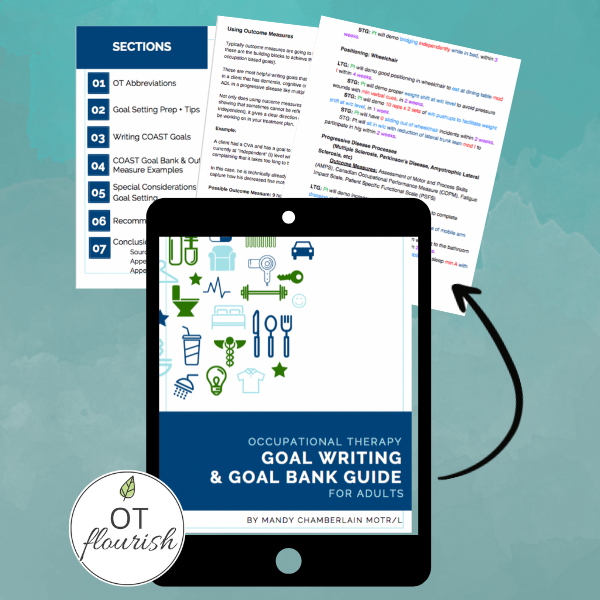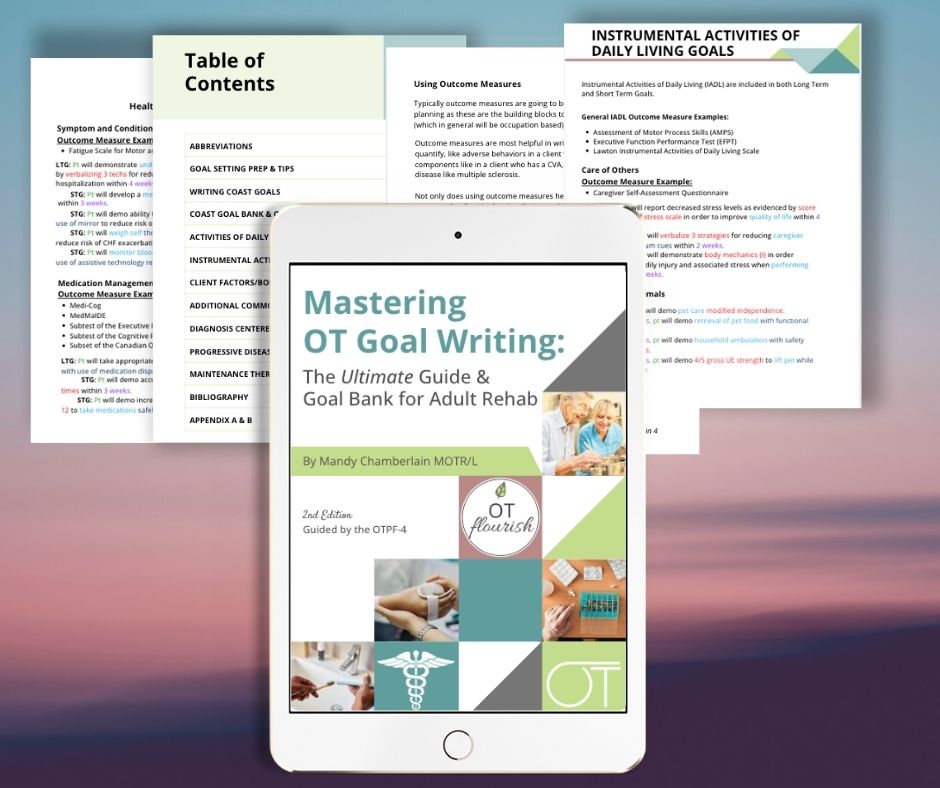When I was a wee student and novice practitioner, I struggled with helping people be more independent with the most embarrassing, intimate part of toileting occupational therapy: wiping
“How does one wipe their bottom?” I bemused ![]()
After some potty parties (AKA toileting), I realized that people toilet all different kinds of ways! I needed to snap out of my own embarrassment as an OT in regards to wiping on the privy.
Why is Toileting Important to Address in Occupational Therapy?
Wiping needed to be addressed, not pushed aside with the hope that it would improve on its own. Instead, I changed my focus to transforming people’s lives for the better with independent wiping!
Safety was another issue for some people. While I want to respect how people do the doo, sometimes things didn’t look very safe. My most memorable incident happened while a patient with right hemiparesis tried to prop her foot up on the toilet seat to wipe.
Yikes! No falls today, ba-by!
I wasn’t certain of what basic things I should have people do while toileting. So after years of helping people in nursing facilities, the community, and the hospital, I’ve narrowed it down to three tips to help people toilet and wipe their butts!
_______________________________________________________________________________________
Want a link to a Toilet Training Occupational Therapy PDF for adults?
Sign up below and get access to this and all the resources available in the Free Level of the OT Accelerator _______________________________________________________________________________________
_______________________________________________________________________________________
How Can Occupational Therapy Help with Toileting?
3 main toileting activities and strategies used in toileting occupational therapy include:
- educating on sitting while wiping
- optimal positioning of the patient
- instructing & adapting so they can wipe front to back
Let’s dig in!
1) Sit While Wiping
Yes, it really is that simple. No, this is not common sense because I’ve seen too many other variables.
The first toileting occupational therapy tip is to sit on the toilet with both feet on the ground and your rear on the center of the seat. Sitting gives you a wide base of support to balance yourself while you bend to reach and wipe. Many people think they can reach better by standing and twisting to wipe thoroughly.
I totally get it. They feel desperate to get the job done and move on with their day, but toileting occupational therapy tips like this is helpful for the right patient!
However, you’re most likely working with someone who has back pain, dizziness, or some other kind of visual perception condition that’s going to hamper their wiping game. Sitting down helps people feel more secure and improves their focus on the actual wiping. People are more open to your guidance on how to clean themselves better when they’re not fighting gravity to maintain a standing position. It’s our job as OT practitioners to educate people on better, safer toileting habits and to take care of their private time on the privy!
Tell them that they’ll wipe easier, be safer, and avoid more injuries down the line in the bathroom.
Wiping. Better. Faster. Stronger.
2) Positioning
It’s fact time – I know you love learning new things because of what you chose to do for a living 🙂
The number two place to fall at home is . . . off of the toilet (CDC, 2011)!

And oh man, have I seen this in action in the clinic…so many falls off toilets! Now, not everyone tells me exactly what they were doing on the toilet while they were falling, but I have a strong suspicion that it had to do with wiping.
When instructing in toileting occupational therapy, make sure the patient is positioned so they can feel clean and are less likely to fall off the toilet. When people are sitting on the center of the toilet, have them place their ankles, knees, and hips in 90-degree angles. This will help your patient sit as tall as they can and provide stability while they reach to wipe.
Oh yeah – gimme that proximal stability!
Of course, you will come across people who are very tall or very short and the 90-degree angle thing won’t work. Check out this article on toilet seat height to help you figure out the right seat height for clients.
3) Wipe Front to Back
This toileting occupational therapy tip is incredibly important for people with female anatomy. Wiping front to back helps keep fecal bacteria from the urethra and vagina. Fecal bacteria can cause unwanted infections, like urinary tract infections.
Wiping front to back can be really difficult for a number of reasons including:
- shoulder joint conditions
- toileting fine motor and grip problems
- coordination
- limited functional reach, etc.
Sometimes it’s helpful to break down toileting occupational therapy wiping task by having people wipe anteriorly then reaching behind their back to wipe their posterior. I always cringe when I see patients wipe back and forth with the same piece of toilet paper. I just think about all the germs that go from their butt to the vagina and urethra! Wiping front to back hands down helps prevent all booty infections.
It’s even better to use water to become thoroughly clean, which can be used through a bidet seat attachment. If you use water, it’s the same principle, front to back. Try to aim the water stream so no fecal matter gets into the urethra.
There can be some issues with aim when using a bidet. A lot of bidet seats nowadays have a “feminine” wash option where the stream of water directly cleans the urethra.

If wiping front to back is too difficult because of an inability to reach, introduce the idea of using adaptive equipment, like personal hygiene wands. Personal hygiene wands also go by the name toilet wands. There are many different types out there that come in different lengths and with different releasing mechanisms. Take a look at more bathroom solutions here.
There are a couple of brands that I like using with people, like the Freedom Wand. It has unique “fingers” that grip the toilet paper. It’s easy to use and length adjustable to reach around bellies and bottoms.

Another brand that I enjoy immensely is Buckingham Easywipe Toilet Aid. This tool was designed by an occupational therapist and works well for one-handed use. It also folds up which makes it convenient for people to carry it into the community.


What are Some OT Toileting Assessments?
Adult toileting can be assessed by occupational therapists utilizing a ADL assessment such as the Modified Barthel Index or utilizing specific toileting occupational therapy assessments such as:
- Minnesota Toileting Skills Questionnaire (MTSQ)
- Performance Oriented Timed Toileting Instrument (POTTI)
What are Examples of Toileting Goals for Occupational Therapy Adults?
Depending on the patient and what are the limitations to the occupational performance of toileting, an example of toileting goals include:
- Long Term Goal: Patient will complete toileting with supervision at standard toilet within 5 weeks.
- Short Term Goal: Patient will complete clothing management with minimum assistance at bedside commode within 3 weeks.
- Short Term Goal: Patient will demonstrate toileting with fair dynamic standing balance at bedside commode within 3 weeks.
This shows the payers (like Medicare and other health insurance companies) that the individual is benefiting from your OT services as evidenced by their progress and it helps you write more client centered and objective goals (get the ebook: Occupational Therapy Goal Writing, Objective Measures + Goals Bank (for adults!) for more details on how to use the color coded system and write rock solid, amazing goals! ![]() )
)
In Conclusion, Toileting Occupational Therapy is a Necessity!
For most patients, sitting down, positioning, and wiping front to back make all the difference in the world. They should be good to go (pun intended)!
For other patients, this will be a good start before diving into more toileting interventions involving adaptive equipment, lifts, or durable medical equipment. I’m a firm believer in positioning and modifying the environment to help people wipe better.
About our guest blogger:
 Maria Lindbergh, MOT, OTR/L, ECHM is passionate about helping patients poop on the toilet! She created a course, “Hard Time Wiping? Let’s Talk A-booty It!” that shares toilet techniques and four options to clean your bottom easier. Maria also loves supporting people to create beautiful, safe bathrooms through her website, Toilet Talk.
Maria Lindbergh, MOT, OTR/L, ECHM is passionate about helping patients poop on the toilet! She created a course, “Hard Time Wiping? Let’s Talk A-booty It!” that shares toilet techniques and four options to clean your bottom easier. Maria also loves supporting people to create beautiful, safe bathrooms through her website, Toilet Talk.
Please contact me with any toileting occupational therapy or bathroom-related questions!
Resources:
Reliability and Validity of Two Measures of Toileting Skills in Frail Older Women Without Dementia
*Some of the links in this post are affiliate links. This won’t add any cost to you, but it helps me provide free content on OTflourish.com. I wouldn’t recommend something I don’t believe in – thank you!








2 thoughts on “3 Top Toileting Occupational Therapy Tips & Tricks”
Great stuff. I work with toileting issues and I’m always running across your work. Thank you.
So glad it’s helpful Tom!